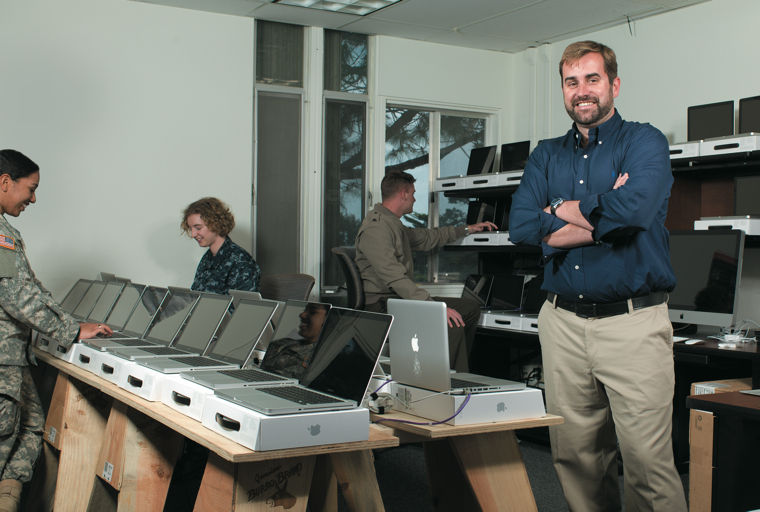How iPads Help American Troops Learn Foreign Languages
At the Defense Language Institute Foreign Language Center, students don’t just learn a new language, they are immersed in it. And these days, they’re using state-of-the-art technology to bolster their learning.
Based in Monterey, Calif., the DLIFLC teaches languages to some 3,500 students, most of them enlisted members of the Army, Air Force, Navy or Marine Corps. Depending on the difficulty of the language, students spend anywhere from 26 to 64 weeks — five days a week, seven hours a day — mastering a new tongue. That’s in addition to several hours of military training and homework each day. And they’re also expected to practice the language outside of the classroom.
If students aren’t sleeping, the center wants them to be learning. That’s why DLIFLC has distributed notebook computers and iPod touch devices to its full-time students since 2005, says Chief Technology Officer Jonathan Russell. So when they’re waiting for a bus or passing the time between classes, students can listen to their language recited by native speakers.
“Language learning correlates directly to time on task,” he says. “It’s simple math. The more practice you have, the better you get.”
Eighteen months ago, the center decided it was time to trade in its iPods for iPads, buying nearly 6,000 tablets for students and faculty.
“The decision to move from the iPod to the iPad was largely to increase screen real estate,” he says. “The iPad offers more access to the touch screen and a larger surface for students to watch videos or practice non-Roman script. Our plan over the next three years is to move all of our curriculum to digital content and go paperless. Right now, it’s available in PDF format, but our curriculum development team is working hard to move into interactive formats like the iBook and ePub. That would allow students to use their mobile devices as interactive digital readers.”
In addition to the iPads, DLIFLC also has distributed some 6,000 MacBook Pro notebooks to teachers and students, and set up 800 interactive whiteboards for use in the classrooms. The MacBook Pros were configured as dual-boot machines, allowing users to run either the Mac OS or Microsoft Windows. DLIFLC also leverages Microsoft SharePoint and other learning management software for each student and faculty member on the network, allowing them to save their work and access classroom materials via Wi-Fi.
The goal over the next three years is to phase out notebooks in favor of tablets, at least for the students, says Russell.
“We did a cost-benefit analysis and realized we could save taxpayers money going with tablets,” he says. “As we move from 10 years of war into peace, we know we’ll have to do more with less. Once we get to the point where we can deliver all the functionality of a full operating system on a mobile platform, we’ll do that.”
Head of the Class
Last fall, DLIFLC began distributing the new gear to its Persian Farsi school, followed by the Multi Language School, where students learn Dari, Hindi, Indonesian, Pashto, Punjabi, Turkish, Urdu and Uzbek. By the end of this school year, all students and faculty should have new iPads and MacBooks, Russell says.
Even over a relatively short time, the change in the classroom has been remarkable, says Zalmai Roashan, chair of the Pashto Language Department at the center.
“The iPad has absolutely changed how I teach, mainly because it’s so portable,” he says. “I can download curriculum onto the iPad and carry it from classroom to classroom, or use it to access my SharePoint folder. I’m not that tech-savvy, so the user-friendly nature of both the iPad and MacBook Pro is a blessing. Most of the faculty members here have become so dependent on them that if we lost access to the Wi-Fi network, we’d be absolutely lost.”

Credit: Cody Pickens
Number of languages taught by DLIFLC instructors, from Arabic to Uzbek
Students can bring their MacBooks to class and connect to a whiteboard to display their work. The center is replacing most of its projector/whiteboard setups with LED flat-screen displays, Russell says. It’s also running a pilot program using Apple TV set-top boxes as a video source, which would make it easy for students to connect wirelessly from their iPads to the whiteboards.
“Ninety-nine percent of what I do is trying to save students and faculty members time,” he says. “If they can connect to an external display with two clicks on an iPad, instead of spending two minutes unhooking one laptop to a display and attaching another one, that’s great.”
But the greatest benefit of having iPads in the classroom is that they put a wide variety of study materials at students’ fingertips, says Specialist Tyler Benjamin, an Army private who’s studying with Roashan at the Multi Language School. Having a constant Internet connection makes it easier to access audio and video of native speakers, as well as dictionaries, news stories and other materials written in the language being studied, he says.
“Pashto is not a very common language,” Benjamin says. “Most people outside the military do not know what it is. And we don’t have access to the kind of language resources that, say, the Chinese or Spanish departments might have. So for us, technology is invaluable. This is the only way we have to hear common speech, colloquialisms, the language we would use day to day. Though some people might think of them as a luxury, these kinds of tools are quite necessary to get the full grasp of the language.”
Security First
Getting to an all-mobile environment required a lot of upfront planning, says Russell, especially when it came to security.
“Being part of the Defense Department, that’s the first thing we thought about,” he says. “Selecting the right mobile device management solution for our environment was huge. We also spent a lot of time getting the configuration right. We were walking a fine line between giving our users enough capability to be fully functional, but not so much that they’d get themselves in trouble. And we definitely needed it to be hardened from outside vulnerabilities.”
The DLIFLC ended up going with JAMF Software’s Casper Suite, which allows the center to manage mobile security, track down lost or stolen devices and wipe them remotely if necessary. So far, Russell says, only one iPad has been lost, and administrators were able to find it pretty quickly.
Fortunately, connectivity and bandwidth were not roadblocks to the upgrade. The center upgraded to a new 802.11g/n Wi-Fi network shortly before making the switch to iPads and MacBooks, Russell says. DLIFLC also has access to a 10 Gigabit Ethernet backbone, courtesy of the Corporation for Education Network Initiatives in California (CENIC), a public/private consortium that provides low-cost Internet bandwidth for California schools.
“Eighty percent of our network traffic is IP video,” he says, “so we wanted to make sure our pipes were big enough to handle the load. Our Wi-Fi connection speeds are very fast, but the last thing we needed was a bottleneck. So far — knock on wood — the network is holding up quite nicely.”
The other key aspect of smoothing the transition was training. Not for the students, who are largely digital natives, but for the teachers, says Russell.
“I underestimated the amount of training we would need for the faculty,” he admits. “We spent a lot of time in there, but it was time well spent.”









